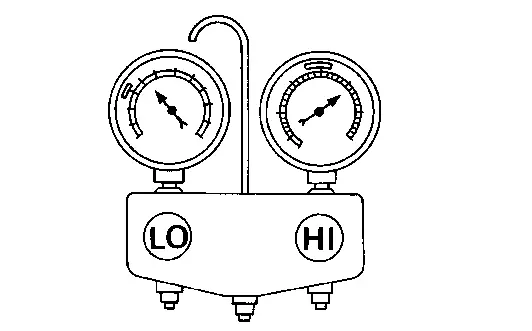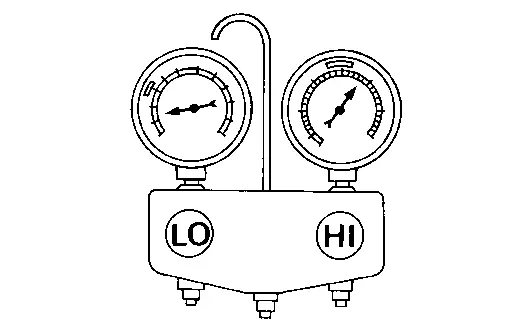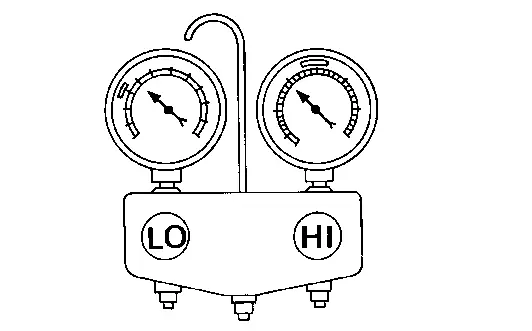Nissan Pathfinder: Heater & Air Conditioning System - Symptom Diagnosis
Heater and Air Conditioning System Symptoms Nissan Pathfinder
Symptom Table
SYMPTOM TABLE
| Symptom | Reference Page | |
|---|---|---|
| A/C system does not come on. | Go to Trouble Diagnosis Procedure for A/C System. | Diagnosis Procedure |
| A/C system cannot be controlled. | Go to Self-diagnosis Function. | Work Flow |
| Front air outlet does not change. | Go to Trouble Diagnosis Procedure for Front Mode Door Motor. | DTC Diagnosis Procedure |
| Mode door motor (front) is malfunctioning. | ||
| Rear air outlet does not change. | Go to Trouble Diagnosis Procedure for Rear Mode Door Motor. | DTC Diagnosis Procedure |
| Mode door motor (rear) is malfunctioning. | ||
| Front discharge air temperature does not change (LH side). | Go to Trouble Diagnosis Procedure for Air Mix Door Motor LH. | DTC Diagnosis Procedure |
| Air mix door motor LH is malfunctioning. | ||
| Front discharge air temperature does not change). | Go to Trouble Diagnosis Procedure for Air Mix Door Motor RH. | DTC Diagnosis Procedure |
| Air mix door motor RH is malfunctioning. | ||
| Rear discharge air temperature does not change. | Go to Trouble Diagnosis Procedure for Air Mix Door Motor (Rear). | DTC Diagnosis Procedure |
| Air mix door motor (rear) is malfunctioning. | ||
| Intake door does not change. | Go to Trouble Diagnosis Procedure for Intake Door Motor. | DTC Diagnosis Procedure |
| Intake door motor is malfunctioning. | ||
| Front blower motor operation is malfunctioning. | Go to Trouble Diagnosis Procedure for Front Blower Motor. | Diagnosis Procedure |
| Rear blower motor operation is malfunctioning. | Go to Trouble Diagnosis Procedure for Rear Blower Motor. | Diagnosis Procedure |
| Magnet clutch does not engage. | Go to Trouble Diagnosis Procedure for Magnet Clutch. | Diagnosis Procedure |
| Insufficient cooling (front). | Go to Trouble Diagnosis Procedure for Insufficient Cooling. | Diagnosis Procedure |
| Insufficient cooling (rear). | Go to Trouble Diagnosis Procedure for Insufficient Cooling. | Diagnosis Procedure |
| Insufficient heating (front). | Go to Trouble Diagnosis Procedure for Insufficient Heating. | Diagnosis Procedure |
| Insufficient heating (rear). | Go to Trouble Diagnosis Procedure for Insufficient Heating. | Diagnosis Procedure |
| Noise. | Go to Trouble Diagnosis Procedure for Noise. | Symptom Table |
| Both high- and low-pressure sides are too high. | Go to Trouble Diagnosis Procedure for Abnormal Pressure. | Trouble Diagnosis For Unusual Pressure |
| High-pressure side is too high and low-pressure side is too low. | Go to Trouble Diagnosis Procedure for Abnormal Pressure. | Trouble Diagnosis For Unusual Pressure |
| High-pressure side is too low and low-pressure side is too high. | Go to Trouble Diagnosis Procedure for Abnormal Pressure. | Trouble Diagnosis For Unusual Pressure |
| Both high- and low-pressure side sometimes becomes negative. | Go to Trouble Diagnosis Procedure for Abnormal Pressure. | Trouble Diagnosis For Unusual Pressure |
| Low-pressure side sometimes becomes negative. | Go to Trouble Diagnosis Procedure for Abnormal Pressure. | Trouble Diagnosis For Unusual Pressure |
| Low-pressure side becomes negative. | Go to Trouble Diagnosis Procedure for Abnormal Pressure. | Trouble Diagnosis For Unusual Pressure |
Refrigeration System Symptoms Nissan Pathfinder R53
Trouble Diagnosis For Unusual Pressure
Diagnose using a manifold gauge whenever system’s high and/or low side pressure(s) is/are unusual. The marker above the gauge scale in the following tables indicates the standard (usual) pressure range. Refer to Inspection.
Symptom Table
| Gauge indication | Refrigerant cycle | Probable cause | Corrective action |
|---|---|---|---|
|
Both high and low pressure sides are too high.
|
The pressure returns to normal soon after sprinkling water on condenser. | Overfilled refrigerant. | Recover refrigerant, evacuate system, and recharge with the specified amount of refrigerant. Refer to Recycle Refrigerant. |
| Air flow to condenser is insufficient. |
Insufficient condenser cooling performance.
|
|
|
| When A/C compressor is stopped, a high-pressure reading quickly drops by approximately 196 kPa (2 kg/cm2, 28 psi). It then gradually decreases. | Air mixed with refrigerant. | Recover refrigerant, evacuate system, and recharge with the specified amount of refrigerant. Refer to Recycle Refrigerant. | |
|
Expansion valve opened too much (excessive flow of refrigerant). | Replace expansion valve. | |
|
High-pressure side is excessively high and low-pressure side is too low.
|
High-pressure pipe and upper side of condenser become hot, however, liquid tank does not become so hot. | Clogged or crushed high-pressure pipe located between A/C compressor and condenser. | Repair or replace the malfunctioning parts. |
|
High-pressure side is too low and low-pressure side is too high.
|
|
Malfunction in A/C compressor system (insufficient A/C compressor pressure operation).
|
Replace A/C compressor. Refer to Removal and Installation. |
|
Both high and low pressure sides are too low.
|
|
Clogged expansion valve.
|
Eliminate foreign material from expansion valve or replace it. |
|
Malfunction inside liquid tank (clogged strainer). | Replace condenser (includes liquid tank). Refer to Removal and Installation. | |
| Evaporator becomes frosted. | Clogged or crushed low-pressure pipe. | Repair or replace malfunctioning parts. | |
| Malfunction in intake air temperature sensor. | Check intake sensor system. Refer to Component Parts Location. | ||
| There is a small temperature difference between the high and low pressure pipes for refrigerant cycle. |
|
|
|
|
Low-pressure side sometimes becomes negative.
|
|
|
|
| Hunting in high-pressure side. | There is no temperature difference between high and low-pressure sides. | Malfunctioning variable valve in A/C compressor. |
|
Noise Nissan Pathfinder R53
Symptom Table
| Symptom | Noise source | Probable cause | Corrective action |
|---|---|---|---|
| Unusual noise from A/C compressor when A/C is ON. | Inside of A/C compressor | Worn, broken, or clogged internal components. | Check compressor oil. Refer to Inspection. |
| Magnet clutch | Contact of clutch disc with pulley. | Check clearance between clutch disc and pulley. | |
| A/C compressor body | Loose A/C compressor bolts. | Check torque of bolts. Refer to Exploded View. | |
| Unusual noise from cooler piping. | Cooler piping (pipe and flexible hose) | Improper installation of clip and bracket. | Check installation of cooler piping. Refer to Exploded View. |
| Unusual noise from expansion valve when A/C is ON. | Expansion valve | Low refrigerant charge. |
|
| Worn, broken, or clogged internal components. | Eliminate foreign material from expansion valve or replace it. | ||
| Unusual noise from belt. | — | Loose belt. | Check belt tension. Refer to Checking Drive Belt. |
| Damaged or broken components inside A/C compressor. | Replace A/C compressor. Refer to Removal and Installation. |

Nissan Pathfinder (R53) 2022-2025 Service Manual
Symptom Diagnosis
Contact Us
Nissan Pathfinder Info Center
Email: info@nipathfinder.com
Phone: +1 (800) 123-4567
Address: 123 Pathfinder Blvd, Nashville, TN 37214, USA
Working Hours: Mon–Fri, 9:00 AM – 5:00 PM (EST)





